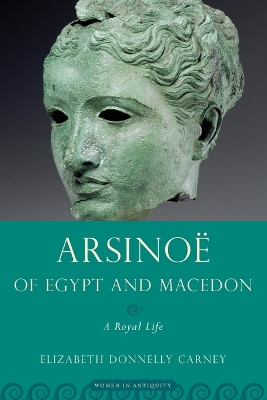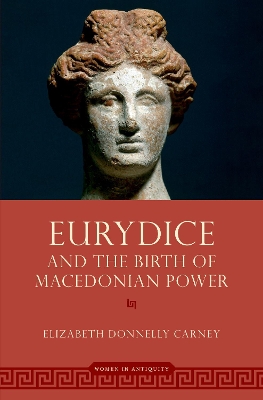Women in Antiquity
2 total works
The life of Arsinoe II (c. 316-c.270 BCE), daughter of Ptolemy Soter, the founder of the Ptolemaic dynasty, is characterized by dynastic intrigue. Her marriage to her full brother Ptolemy II, king of Egypt, was the first of the sibling marriages that became the "dynastic signature" of the Ptolemies. With Ptolemy II, she ended her days in great wealth and security and was ultimately deified. However, in order to reach that point she was forced to endure two
tumultuous marriages, both of which led her to flee for her life, leaving war, murder, and bloodshed in her wake. Throughout much of her life, Arsinoe controlled great wealth and exercised political influence, but domestic stability characterized only her last few years. Arsinoe was the model for the powerful
role Ptolemaic women gradually acquired as co-rulers of their empire. Her image continued to play a role in dynastic loyalty and solidarity for centuries to come.
Despite the fact that Arsinoe was the pivotal figure in the eventual evolution of regnal power for Ptolemaic women, and despite a considerable body of recent scholarship across many fields relevant to her life, there is no up-to-date biography in English on the life of this queen. Elizabeth Carney, in sifting through the available archaeological and literary evidence, creates an accessible and reasoned picture of this royal woman. In describing Arsinoe's significant role in the courts
of Thrace and Alexandria, Carney dicusses the role of earlier Macedonian royal women in monarchy, the institution of sibling marriage, and the reasons for its longstanding success in Hellenistic Egypt. Ultimately, this book provides a broader view of an integral player in the Hellenistic world.
tumultuous marriages, both of which led her to flee for her life, leaving war, murder, and bloodshed in her wake. Throughout much of her life, Arsinoe controlled great wealth and exercised political influence, but domestic stability characterized only her last few years. Arsinoe was the model for the powerful
role Ptolemaic women gradually acquired as co-rulers of their empire. Her image continued to play a role in dynastic loyalty and solidarity for centuries to come.
Despite the fact that Arsinoe was the pivotal figure in the eventual evolution of regnal power for Ptolemaic women, and despite a considerable body of recent scholarship across many fields relevant to her life, there is no up-to-date biography in English on the life of this queen. Elizabeth Carney, in sifting through the available archaeological and literary evidence, creates an accessible and reasoned picture of this royal woman. In describing Arsinoe's significant role in the courts
of Thrace and Alexandria, Carney dicusses the role of earlier Macedonian royal women in monarchy, the institution of sibling marriage, and the reasons for its longstanding success in Hellenistic Egypt. Ultimately, this book provides a broader view of an integral player in the Hellenistic world.
Eurydice (c.410-340s BCE) played a part in the public life of ancient Macedonia, the first royal Macedonian woman known to have done so, though hardly the last. She was the wife of Amyntas III, the mother of Philip II (and two other short-lived kings of Macedonia), and grandmother of Alexander the Great, Her career marks a turning point in the role of royal women in Macedonian monarchy, one that coincides with the emergence of Macedonia as a great power in the
Hellenic world. This study examines the nature of her public role as well as the factors that contributed its expansion and to the expanding power of Macedonia.
Some ancient sources picture Eurydice as a murderous adulteress willing to attempt the elimination of her husband and her three sons for the sake of her lover, whereas others portray her as a doting and heroic mother whose actions led to the preservation of the throne for her sons. While the latter view is likely closer to historical reality, both the "good" and "bad" Eurydice traditions portray her as the leader of a faction, an active figure at court and in international affairs. Eurydice's
activity, sinister or not, directly related to the fact that, at the time of her husband's death, the eldest of her three sons was barely old enough to rule and enemies, foreign and domestic, threatened. Two of Eurydice's sons were assassinated and the third died in battle.
Eurydice functioned not only a succession advocate for her sons but she also played a part in the construction of the public image of the dynasty, both because of her own actions and because of the ways in which her son Philip II chose to depict and commemorate her. Archaeological discoveries since the 1980s enable us to better understand this development.
Hellenic world. This study examines the nature of her public role as well as the factors that contributed its expansion and to the expanding power of Macedonia.
Some ancient sources picture Eurydice as a murderous adulteress willing to attempt the elimination of her husband and her three sons for the sake of her lover, whereas others portray her as a doting and heroic mother whose actions led to the preservation of the throne for her sons. While the latter view is likely closer to historical reality, both the "good" and "bad" Eurydice traditions portray her as the leader of a faction, an active figure at court and in international affairs. Eurydice's
activity, sinister or not, directly related to the fact that, at the time of her husband's death, the eldest of her three sons was barely old enough to rule and enemies, foreign and domestic, threatened. Two of Eurydice's sons were assassinated and the third died in battle.
Eurydice functioned not only a succession advocate for her sons but she also played a part in the construction of the public image of the dynasty, both because of her own actions and because of the ways in which her son Philip II chose to depict and commemorate her. Archaeological discoveries since the 1980s enable us to better understand this development.

